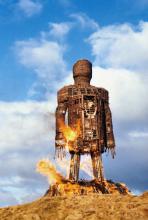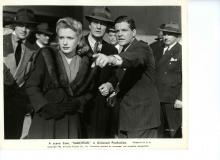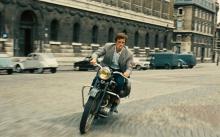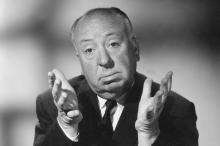How to Watch How I Won the War
By Amanda McQueen, UW Cinematheque Programmer and Project Assistant
I'll admit, the first time I sat down to watch How I Won the War, I didn't make it all the way through. I just wasn't in the mood for a film that asks so much of the viewer. Richard Lester's comedic war satire is deliberately difficult - just as much today as it was for audiences in 1967. Those who didn't understand the film upon its release disliked it; those who did understand it - or, more often, who misunderstood it - were offended. The Rank Organization found the film traitorous and refused to screen it in its theaters on Memorial Day. The New York Times' Bosley Crowther also attacked the film, insisting "war isn't funny." Of course, that was precisely Lester's point: war is not funny, or glamorous, or entertaining. Though it hasn't quite gained the status of an overlooked masterpiece, How I Won the War is a film that bears revisiting, and Steven Soderbergh has called it a fascinating work that only gets better with age. So here are some thoughts about how to watch How I Won the War.
1. Don't worry too much about the plot. Adapted by English playwright Charles Wood from Patrick Ryan's 1963 novel, How I Won the War tells of the comically incompetent Lt. Earnest Goodbody (Michael Crawford), who is given a mission to set up a cricket pitch in enemy territory in North Africa in order to improve morale and impress a visiting officer. While this plot provides a basic through-line, your experience of the film might be more rewarding if you approach it not as a conventional narrative, but as variations on a theme: war may be necessary but it is never noble.
2. It's OK if you don't get all the references. How I Won the War is a dense film, and although it can be read as commentary on Vietnam, the satire is mobilized through British experiences of World War II. Indeed, it is because Lester is criticizing the Good War - rather than a more controversial conflict - that his film was declared unpatriotic. But it is through this historically and culturally specific lens that the film's satire should be read. So the cricket match - that typically British pastime - becomes a symbol not only for the idea of war as a game, but also for the film's commentary on the upperclass military officers. There are also the recreations of actual battles: Dunkirk, Dieppe, El Alamein, and Arnhem. Staged as skirmishes in which Goodbody's men fight and die, these battles serve as reminders of real-life tactical errors and a critique of British Army commander Bernard Law Montgomery's leadership. Some of this is made evident in the film, but if you’re not aware of things like the irreverence toward Montgomery or the classist associations of cricket, then the satire can be hard to fully grasp. However, that's all right, because the film has another point of entry.
3. If you're not a WWII history buff, focus on the critique of war movies. Lester found films like Stanley Kubrick's Paths of Glory (1957) condemnable for presenting war as entertainment. So How I Won the War attempts to deconstruct conventional war films by undermining tropes like the important assignment, the noble sacrifice of those killed, and the fostering of camaraderie under adversity. Humorous references to these conventional war films, such as The Bridge on the River Kwai (1957), also abound. Though many critics chastised Lester's film for not treating war with respect, the director believed that it was far more respectful than something like The Dirty Dozen (1967), because it was "doing everything in one's power to say, 'For God's sake, don't use war as entertainment: aren't you ashamed?'" And since we are still surrounded by mediated images of war - the Brad Pitt vehicle Fury being just the most recent example - we are well equipped to handle this aspect of the film's indictment.
4. Embrace the Brechtianism. Like Jean Luc Godard's Les carabiniers (1963), How I Won the War attempts to bring Bertolt Brecht's techniques of distanciation into mainstream cinema. So Lester continually disrupts the narrative, reminding viewers that they are watching a movie and refusing to allow them to identify with characters or experience sympathy for the situations. As Neil Sinyard notes, the film is "structured like a minefield, ready to explode" when you least expect it. There are dramatic jumps in time and space. Actors break the fourth wall. Archival footage is intercut with new footage, in both color and black and white. And there are odd, surrealist touches, such as the brightly colored dead soldiers that follow Goodbody's troop. Lester has admitted recently that some of these techniques were perhaps a mistake, as they alienated audiences, but they seemed the best way to achieve the film's goals at the time. And today, they still offer a fascinating example of political argument through stylistic and narrative experimentation.
5. Enjoy Roy Kinnear. How I Won the War is perhaps best remembered for John Lennon's appearance as the kleptomaniac Gripweed. This was Lennon's third film with Lester - after A Hard Day's Night (1964) and Help! (1965) - and it is reportedly the film to which one of the verses of the Beatles' "A Day in the Life" refers:
I saw a film today, oh boy
The English army had just won the war
A crowd of people turned away
But I just had to look
Having read the book
But How I Won the War features other notable performances, including one from fantastic British character actor Roy Kinnear, who also appeared in several of Lester's films and was a close friend of the director. Personally, I always find a film improved by Kinnear's presence.
It's important to see How I Won the War as the product of its time. Lester was young and disillusioned and created an angry film that was determined to make audiences ashamed of what they were watching. Even if it takes more than one viewing to fully absorb what Lester's trying to do, How I Won the War is ultimately worth the effort.
A 35mm print of Charles Chaplin's Shoulder Arms begins a Cinematheque series honoring the 100th anniversary of the start of World War I on Saturday, November 1 at 7 p.m. Shoulder Arms will be immediately followed by a 35mm print of the decidedly World War II-based How I Won the War.










